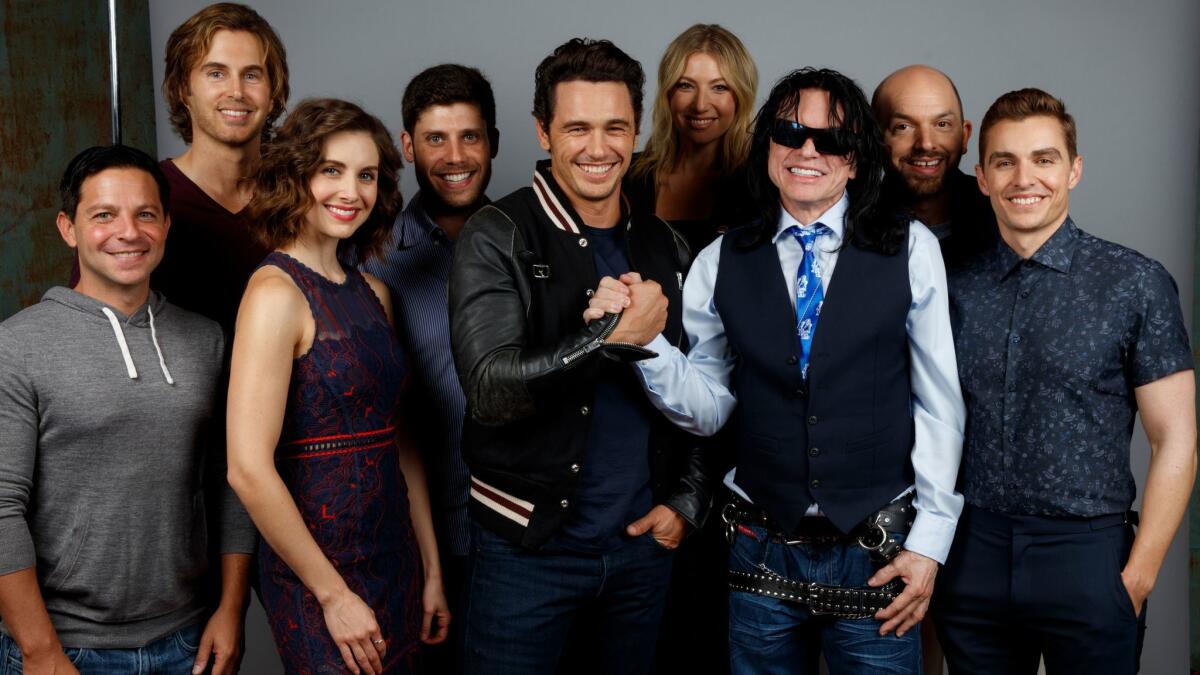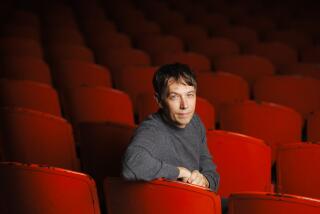Review: James Franco’s ‘The Disaster Artist’ is a hilarious, heartening celebration of failure
Sometime in 2003, a billboard sprang up over Highland Avenue advertising a new movie called “The Room,” adorned with a screening RSVP hotline and the strange, looming mug of its writer, director, producer and star, Tommy Wiseau.
Unlike some of my more adventurous colleagues, I never called the number or attended a screening, not even after the movie — a work of reportedly transcendent, Olympian awfulness — went from indie curio to cult phenomenon, driven by some of the strongest so-bad-it’s-good reactions since “Plan 9 From Outer Space” or “Troll 2.”
But I still remember the billboard (it stayed up for years) and Wiseau’s comically sinister expression, his left eye frozen mid-blink, as if he were both the teller and the butt of his own joke. That’s as good a metaphor as any for the curious fate that has befallen “The Room,” which in the 14 years since its release has gone beyond the usual parameters of audience reappraisal.
Widely hailed as the best worst movie ever made, and regularly revived at fan screenings with Wiseau often in attendance, it offers a heartening reminder that while mediocrities are a dime a dozen, a genuine, off-the-charts fiasco is something to cherish.
“The Disaster Artist,” James Franco’s shrewd, affectionate and squirmingly funny new movie, understands this completely. Approaching “The Room” in a spirit of mocking celebration, it is both a re-creation of its making and a deconstruction of its mystique, as well as a sincere tribute from one iconoclast to another. Franco, an excellent if erratic actor, also happens to be one of the most prolific American independent filmmakers under 40. In both taking the directorial reins and stepping into the role of Wiseau himself, he has hit a kind of meta-moviemaking sweet spot and ascended to his own levels of all-consuming Wiseauean commitment.
Wiseau sightings and impersonations, of course, have become almost as much a fixture of the L.A. scene as the palm trees and Beverly Hills storefronts we see in one of the movie’s early scene-setting montages. But Franco’s breathtakingly sustained performance is no mere exercise in mimicry. From the moment we encounter his Tommy at a San Francisco actors’ workshop in 1998, a hulking man of mystery with long black hair, a pallid complexion and a vaguely Eastern European accent, he seems to have become possessed by a winking, friendly but far-from-benign spirit.
Tommy is a terrible but impressively uninhibited actor, and an inspiration for a shy 20-year-old up-and-comer like Greg Sestero (Dave Franco). The two are soon best friends, bonding over pizza, acting tips and a love of James Dean, whose go-for-broke Method histrionics in “Rebel Without a Cause” inspire them to try their luck in Hollywood. It helps that Greg is able to crash with Tommy, who’s wealthy enough to already have a one-bedroom apartment in L.A. (The source of Tommy’s riches, like his true age and place of origin, is still unknown.)
More handsome than talented, Greg auditions and even lands an agent (Sharon Stone, one of several Hollywood veterans making sly cameos), but his efforts are received with the industry’s usual shrug of indifference. Tommy, by contrast, is rejected by producers and casting directors like a virus — no surprise, given his unshakable accent and his “malevolent presence,” which suggests his true artistic model isn’t James Dean but Bela Lugosi.
“Nobody like me, Greg,” he whines, “Nobody give me chance.” But genius, or whatever, finds a way, and in a burst of creative inspiration, Wiseau writes the screenplay for “The Room,” proudly presenting it to Greg as “greatest drama since the Tennessee Williams.” Williams is indeed among Tommy’s inspirations, along with Brando, Hitchcock and Shakespeare, though a close study of the red-walled apartment in which most of “The Room” is set also suggests a smattering of David Lynch and Cinemax.
If you’ve never seen Wiseau’s cinematic folly, I can attest that watching it at home will do little to dull the sheer, mesmerizing force of its ineptitude. A hothouse melodrama centered around a “true American hero” named Johnny (played by Wiseau himself), it is at worst a farrago of bad hair and miserably stilted line readings, and at best an otherworldly imitation of life, punctuated by endless softcore sex scenes shot and edited to look as if someone fell asleep on the “dissolve” button.
James Franco and his collaborators tease out the backstory behind those moments by way of a meticulous reconstruction of “The Room’s” not-quite-40-day shoot. Adapted by Scott Neustadter and Michael H. Weber from Sestero’s 2013 memoir, the script follows Tommy and Greg as they enthusiastically buy cameras (film and digital), hire a leading lady named Juliette Danielle (Ari Graynor) who will star opposite Tommy and Greg themselves and assemble a crew that includes a script supervisor, Sandy Schklair (an excellent Seth Rogen), who seems to realize a minute before everyone else just how bad things are about to get.

On one level, “The Disaster Artist” is a timeless chronicle of incompetence, jealousy, verbal abuse and delusions of grandeur — which is to say, it’s a canny, even straightforward look at the controlled chaos that can ensue on any film set. On another level, the movie works as an extended series of comic bits in which the inexplicable is forever being explained and re-explained: why it’s hilarious, for instance, that a character in “The Room” played by the actress Carolyn Minnott (herself played by Jacki Weaver) should suddenly announce, and then never again mention, that she has breast cancer.
Spelling out a joke may be the quickest way to kill it, but the obvious, expository nature of the mockery in “The Disaster Artist” doesn’t make it any less funny or illuminating. (There is something about Johnny’s already repetitive “I did not hit her” monologue that makes it sound even better with further repetition.) In a sense, the filmmakers aren’t just annotating “The Room”; they’re also sharing in and perpetuating the cult of fandom surrounding it. Like Wiseau’s most passionate groupies, they all but erase the line where derision ends and exaltation begins.
In that respect, casting the Franco siblings as Tommy and Greg was an inspired stroke, giving them and this comedy an intimate sense of personal investment. You forget the two actors are related as you watch them bond and bicker, and then suddenly a moment — a shared backslap, a pre-shooting pep talk — will offer a poignant, emotionally layered reminder. Dave Franco offers invaluable support here; always good at playing the hapless naif, he comes forcefully into his own as Greg tries to break free of Tommy and pursue his own destiny.
As for James Franco, you sense that he looked at Tommy Wiseau and saw not just the surface mannerisms — the nightmarish chuckle, the dead-eyed stare, the atrocious grasp of subject-verb agreement — but also an eerily kindred spirit. There is something in Franco’s own directorial efforts, like “As I Lay Dying” and “Child of God,” that speaks to Wiseau’s love of the American literary tradition.
And while Franco is an incalculably better filmmaker than his subject — the fluidity of the handheld camerawork in “The Disaster Artist” removes all doubt — there is something in those earlier efforts, with their stripped-down, even primitive aesthetics, that echoes Wiseau’s own desire to capture the human condition at its rawest.
The final act, culminating at “The Room’s” world premiere, sends you out on a welcome comic high that nonetheless leaves quite a bit unsaid. The story of how Wiseau turned his great cinematic lemon into zeitgeist lemonade is both heartening and instructive, but it also hints at darker secrets and unknowns that this movie’s upbeat dimensions can’t entirely capture. But if Franco’s performance feels like a mystery that the filmmakers can’t bring themselves to solve, there’s no denying that, like “The Room” itself, it’s certainly something to see.
------------
‘The Disaster Artist’
Rating: R, for language throughout and some sexuality/nudity
Running time: 1 hour, 44 minutes
Playing: Arclight Cinemas, Hollywood; AMC Century City 15, Century City; and the Landmark, West Los Angeles
See the most-read stories in Entertainment this hour »
Movie Trailers
More to Read
Only good movies
Get the Indie Focus newsletter, Mark Olsen's weekly guide to the world of cinema.
You may occasionally receive promotional content from the Los Angeles Times.









